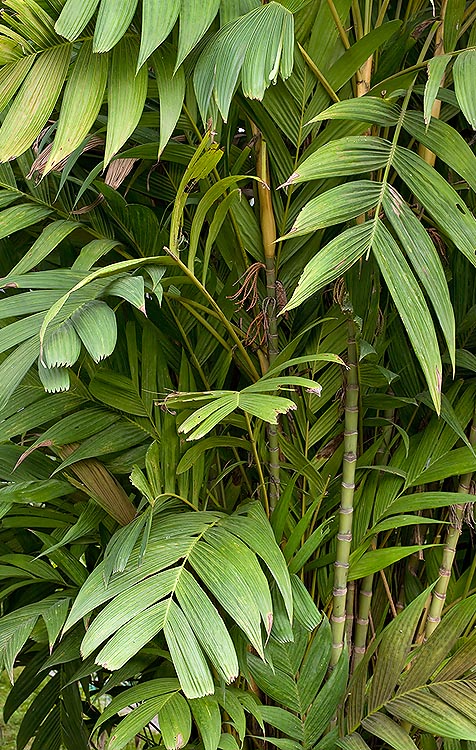Family : Arecaceae

Text © Pietro Puccio

English translation by Mario Beltramini

The Pinanga coronata is a tropical caespitose palm with 2-3 m stems © G. Mazza
The name of the genus is the Latinization of the Malaysian name “pinang”; the name of the species is the Latin word “coronatus” = crowned, of obscure reference.
Common names: ivory cane palm (English); bing-bin, piji, pinang rante (Java).
The Pinanga coronata (Blume ex Mart.) Blume (1839) is a caespitose, monoecious plant, rather variable, with erect stems, 2-5 m tall, with a diameter of 3-5 cm, smooth, of green colour on which stand out the rings trace of the junction of the fallen leaves.
The leaves are pinnate, usually ascending, 1,5 m long on an about 30 cm long petiole, of intense green colour and subdivided into pleated segments, about 25-70 cm long and of variable width, with sharp or truncated and toothed tip; the leaves, when opening, are often pink with light dots. The basal sheath of the leaf, of yellowish green colour, wraps wholly the stem for a length of about 30-50 cm.
The inflorescences come out under the leaves, are about 30 cm long, ramified and hanging, of pink colour tending to the coral red when in fruit; the flowers, disposed in the classical triad (one female between two male flowers), and are small and cream-white.
The ovoid fruits, placed on two opposite rows, are about 12 mm long, of red colour turning to black when ripe. It reproduces by seed and by division; the seeds germinate in 1-3 months at the temperature of 24-28 °C.
Plant of remarkable ornamental value, it stands among the most cultivated Pinanga, utilizable in the tropical, subtropical and, marginally, warm temperate climate zones, in semi-shaded position and in fertile soils, slightly acidic or neutral, perfectly draining and kept constantly humid; it is rather sensitive to the low temperatures as it rarely bears, and for a very short time only, temperatures just under the 0 °C.
It is cultivable also in pot for the decoration of luminous interiors, utilizing substrata rich of organic substance, with addition of coarse and agriperlite, around the 30%, for improving the drainage; temperatures are good not to be lower than 14-16 °C.
Synonyms: Areca coronata Blume ex Mart. (1838); Seaforthia montana Blume ex Mart. (1838); Seaforthia reinwardtiana Mart. (1838); Pinanga costata Blume (1839); Pinanga kuhlii Blume (1839); Pinanga noxa Blume (1839); Seaforthia coronata (Blume ex Mart.) Mart. (1845); Seaforthia kuhlii (Blume) Mart. (1845); Ptychosperma coronatum (Blume ex Mart.) Miq. (1855); Ptychosperma costatum (Blume) Miq. (1855); Ptychosperma kuhlii (Blume) Miq. (1855); Ptychosperma noxa (Blume) Miq. (1855); Ptychosperma album Scheff. (1864); Areca costata (Blume) Kurz (1874); Pinanga sumatrana (Scheff.) H.Wendl. (1875).
→ For general notions about ARECACEAE please click here.
